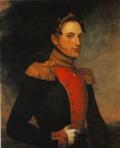Nicolas I, Emperor of Russia
 Nicholas
I (1796-1855), Emperor of Russia from 14th of December 1825. He was
the third son of Emperor Paul I and his second wife Empress Maria Fedorovna.
It was rumored, however, that his father was Daniil Babkin, one of the
courtiers, his mother’s lover at the time, who may also have been the father
of Paul I’s youngest daughter, Anna Pavlovna, future Queen of the Netherlands.
Nicholas
I (1796-1855), Emperor of Russia from 14th of December 1825. He was
the third son of Emperor Paul I and his second wife Empress Maria Fedorovna.
It was rumored, however, that his father was Daniil Babkin, one of the
courtiers, his mother’s lover at the time, who may also have been the father
of Paul I’s youngest daughter, Anna Pavlovna, future Queen of the Netherlands.
Grand Duke Nicholas was not raised as a future emperor. He received the education of a military engineer.
Nicholas was married to Princess Frederika Louisa Charlotte Wilhelmina, (1798-1860), daughter of King Friedrich Wilhelm III of Prussia, named Empress Alexandra Fedorovna. They had 7 children: 4 sons and 3 daughters.
Nicholas became Russian Emperor after the death of his eldest brother Emperor Alexander I, who had no issue, and the abdication of his elder brother Constantine Pavlovich. As Constantine‘s abdication had been kept secret, even from Nicholas, upon hearing of the death of Alexander I in Taganrog, Nicholas publicly acknowledged Constantine as the new emperor, swore allegiance to him and made others do the same. Constatine, however, was not going to ascend the throne and refused to even leave Warsaw.
Because of this confusion, Russia lacked a ruler for a period of 2 weeks and this resulted in the Decembrist Revolt, as the leaders of the North and Southern societies decided that it was a favorable time for insurrection. The revolt was ruthlessly suppressed and the leaders were sentenced to death or exile in Eastern Siberia. The Decembrist Revolt strongly influenced Nicholas I’s political views and he dedicated all his efforts to preserving the absolutist monarchy in Russia.
Nicholas I's internal politics were characterized by ruthless suppression of all political, national and religious groups that were not in line with the government's policies. Such groups included the Petrashevsky Circle and the Society of Cyril and Methodius. Nationalist separatist movements were put down, most notably the Polish Revolt of 1830-31, which led to the Polish Kingdom effectively becoming a part of Russia, as well as suppression of revolts in Central Asia and the Northern Caucuses. Many intellectuals, including notable writers, were persecuted.
Nicholas I's foreign policy was characterized by two general trends: he worked to preserve autocratic rule in Europe, and he saw it as his duty to expand Russia's holdings around the Black Sea and in Central Asia. Nicholas played an important role in suppressing the revolutions of 1848, bolstering the rule of the royal houses of Austria and Prussia. Early in his reign, he fought a war against Turkey (1828-1829), successfully aiding the Christian Orthodox countries of Greece, Bulgaria and Serbia in their struggle for independence from Ottoman rule. This was also the period when the "Great Game" was being played out between Russia and the British Empire for control of Central Asia. These two vectors of tension eventually led to the outbreak of the Crimean War in 1952, towards the end of Nicholas I's reign, which resulted in a humiliating defeat for Russia at the hands of the British and their French allies.
However, Nicholas I would not live to see this. He passed away in 1855,
more than a year before the end of the war. He was succeeded by his son,
Alexander II.
See: Christina Robertson. Portrait
of Empress Alexandra Fedorovna. Portrait
of Empress Alexandra Fedorovna. Portrait
of Empress Alexandra Fedorovna.
Grand Duchess Maria Nikolaevna (1819-1876), eldest and favorite
daughter of Nicholas I. She married Maximilian, the Duke of Leuchtenberg.
This match was below her, as her husband’s father was the step-son of Napoleon
Bonaparte, son of his wife Josephine and her first husband, Viscount de
Beauharnais, and therefore not of royal blood. His suit was accepted because
he was ready to enter Russian service and live with his wife in Russia.
After the death of her father, she married Count Stroganoff, with whom
she had had an affair over a considerable period of time. This morganatic
marriage was, of course, impossible, while Nicholas I was alive, but his
son, the Emperor Alexander II, consented to it.
See: Christina Robertson. Grand
Duchess Maria Nikolaevna with Her Children. Portrait
of Grand Duchess Maria Nikolaevna. Portrait
of Grand Duchess Maria Nikolaevna. Portrait
of Grand Duchess Maria Nikolaevna.
Grand Duchess Olga Nikolaevna (1822-1892), second daughter and
third child of Nicholas I. She married King Karl I of Wurttemberg, then
Crown Prince. The couple had no children, likely due to Karl I's homosexuality.
Olga dedicated her life to charitable work, promoting the education of
girls and support for war veterans and the handicapped. Olga wrote the
memoirs “The Dream of My Youth”
See: Christina Robertson. Portrait
of Grand Duchesses Olga Nikolaevna and Alexandra Nikolaevna. Portrait
of Grand Duchess Olga Nikolaevna.
Grand Duchess Alexandra Nikolaevna (1825-1844), Nicholas I's
youngest daughter. She married Landgrave (Count) Friedrich Wilhelm Karl
George Adolf von Hesse-Kassel. Shortly before her marriage in 1844, Alexandra
contracted tuberculosis, which was attenuated by and complicated her pregnancy
at the time. She died soon after giving birth, together with the child.
See: Christina Robertson. Portrait
of Grand Duchesses Olga Nikolaevna and Alexandra Nikolaevna. Portrait
of Grand Duchess Alexandra Nikolaevna.